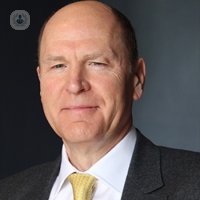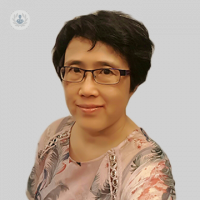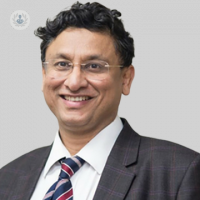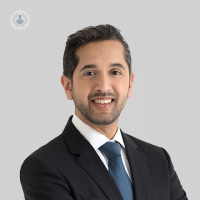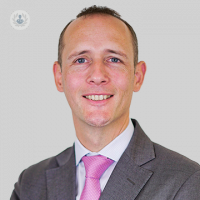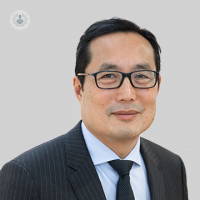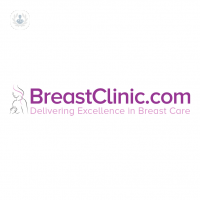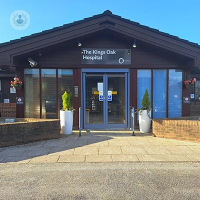What is breast reconstruction?
Breast reconstruction is performed after a mastectomy or a lumpectomy; in some cases, the reconstruction is delayed a few months or years after the breast cancer surgery.
The surgery is performed under general anaesthesia and takes about 8 hours.

Why is it done?
Breast reconstruction is primarily done for aesthetic reasons, and leads to marked improvement in the patient’s self-image. The decision to have breast reconstruction surgery is as valid as the decision to not have it - in all cases, the decision is a personal one.
What does it involve?
There are two ways of performing breast reconstruction: with an implant or with the patient’s own tissue (autologous or “flap” reconstruction).
Breast reconstruction with an implant
Only requires surgery in the chest, hence requires fewer interventions than flap reconstruction. The implant is usually filled with a saline solution, silicone gel or a combination of both, with vegetable oil or silicone on the outside and a saline solution inside. The implant is placed under the pectoralis major muscle. The approximate duration of the implant is between 10 and 20 years.
Autologous or flap reconstruction
in this type of reconstruction, skin, fat and even muscle tissue is used to recreate the shape of the breast. The tissue, called a flap, is taken from the abdomen, back, thighs or breast. In “free flap” techniques, the tissue is completely separated from its original blood vessels, moved to the chest then combined with blood vessels in its new location. In “pedicled flap” techniques, the tissue remains attached to its original blood vessels and is moved under the skin to the chest.
The surgical result lasts for the patient’s lifetime, and this constitutes an advantage of flap reconstructions over implants. There are different types of flap and the one used depends on the patient’s body type, the size of their breasts and whether they want to become a mother in the future.
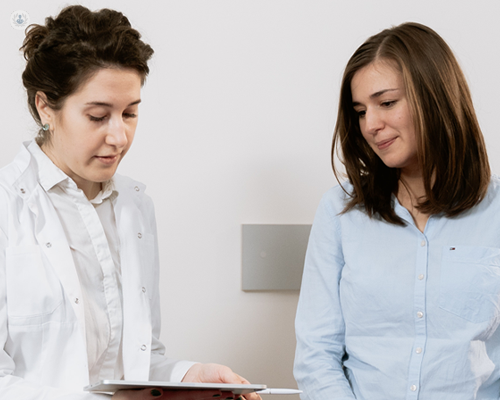
What's involved in preparation for breast reconstruction surgery?
It's important that you follow the surgeon’s instructions, e.g. to stop taking medications such as ibuprofen or aspirin. You will have to stop smoking; you will have to dress as comfortably as possible; and you will have to arrange in advance how to return home after surgery and how to manage during the first few days of recovery.
What is involved in post-operative care?
You will feel tired for a few days after the intervention, and so you should arrange for someone to help you during this time. After the first week, you will be able to take care of yourself.
11-13-2012 11-16-2023Breast reconstruction
Professor Andrew Baildam - Surgery
Created on: 11-13-2012
Updated on: 11-16-2023
Edited by: Karolyn Judge
What is breast reconstruction?
Breast reconstruction is performed after a mastectomy or a lumpectomy; in some cases, the reconstruction is delayed a few months or years after the breast cancer surgery.
The surgery is performed under general anaesthesia and takes about 8 hours.

Why is it done?
Breast reconstruction is primarily done for aesthetic reasons, and leads to marked improvement in the patient’s self-image. The decision to have breast reconstruction surgery is as valid as the decision to not have it - in all cases, the decision is a personal one.
What does it involve?
There are two ways of performing breast reconstruction: with an implant or with the patient’s own tissue (autologous or “flap” reconstruction).
Breast reconstruction with an implant
Only requires surgery in the chest, hence requires fewer interventions than flap reconstruction. The implant is usually filled with a saline solution, silicone gel or a combination of both, with vegetable oil or silicone on the outside and a saline solution inside. The implant is placed under the pectoralis major muscle. The approximate duration of the implant is between 10 and 20 years.
Autologous or flap reconstruction
in this type of reconstruction, skin, fat and even muscle tissue is used to recreate the shape of the breast. The tissue, called a flap, is taken from the abdomen, back, thighs or breast. In “free flap” techniques, the tissue is completely separated from its original blood vessels, moved to the chest then combined with blood vessels in its new location. In “pedicled flap” techniques, the tissue remains attached to its original blood vessels and is moved under the skin to the chest.
The surgical result lasts for the patient’s lifetime, and this constitutes an advantage of flap reconstructions over implants. There are different types of flap and the one used depends on the patient’s body type, the size of their breasts and whether they want to become a mother in the future.

What's involved in preparation for breast reconstruction surgery?
It's important that you follow the surgeon’s instructions, e.g. to stop taking medications such as ibuprofen or aspirin. You will have to stop smoking; you will have to dress as comfortably as possible; and you will have to arrange in advance how to return home after surgery and how to manage during the first few days of recovery.
What is involved in post-operative care?
You will feel tired for a few days after the intervention, and so you should arrange for someone to help you during this time. After the first week, you will be able to take care of yourself.


Is DIEP flap the breast reconstruction method for you?
By Mr Paul Roblin
2024-11-21
The DEIP flap procedure is the most commonly performed breast reconstruction using a patient's own tissue. To help you understand if the DIEP flap method is the right one for you, Mr Paul Roblin provides you with a comprehensive overview of the procedure, what to look for in a surgeon, advantages and disadvantages as well as alternatives. See more


Breast reconstruction after a lumpectomy
By Mr Seni Mylvaganam
2024-11-21
The purpose of a breast lumpectomy is to remove breast tissue to clear a patient of breast cancer. Another name for it is a wide local excision. It is best for smaller breast cancers. The cancer can be safely removed with a margin of normal breast tissue, without causing damage to the remainder of the breast. Mr Seni Myvaganam tells us more about breast reconstruction, following a lumpectomy. See more


Are anatomical (“tear-drop”) implants the best breast enlargement implant for you?
By Professor Charles Malata
2024-11-20
Learn about the numerous benefits of anatomical (“tear-drop”) implants for breast augmentation, what these implants are and if they are suitable for you. See more
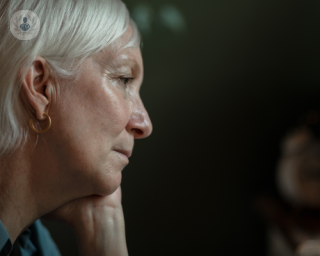

Breast reconstruction surgery: Everything you need to know
By Mr Venkat Ramakrishnan
2024-11-20
The emotional overwhelm that can come with firstly diagnosis, secondly treatment and then prospective mastectomy and breast reconstruction, can be tough. Here to detail breast reconstruction surgery with expert clarity and reassurance is leading plastic surgeon, Mr Venkat Ramakrishnan. See more
Experts in Breast reconstruction
-
Miss Christina Choy
SurgeryExpert in:
- Benign breast lumps
- Breast augmentation
- Breast reconstruction
- Breast cancer
- Mastitis
- Breast ultrasound
-
Professor Jayant Vaidya
SurgeryExpert in:
- Breast cancer
- Mastectomy
- Breast-conserving surgery
- Breast surgery
- Breast lumps
- Breast reconstruction
-
Mr Maisam Fazel
SurgeryExpert in:
- Oncoplastic and reconstructive breast surgery
- Tummy tuck (abdominoplasty)
- Gynaecomastia
- Breast reduction
- Breast reconstruction
- Breast augmentation
-
Mr Kieran Power
Plastic surgeryExpert in:
- Breast surgery
- Body contouring
- Breast reconstruction
- DIEP breast reconstruction
- Skin cancer
- Tummy tuck (abdominoplasty)
-
Mr Mark Ho-Asjoe
Plastic surgeryExpert in:
- Breast augmentation
- Breast reconstruction
- Facelift
- Liposuction
- Rhinoplasty (nose job)
- Tummy tuck (abdominoplasty)
- See all

Breast Clinic
Breast Clinic
The Shard - 32 London Bridge St, London, SE1 9SG
No existe teléfono en el centro.
By using the telephone number provided by TOP DOCTORS, you automatically agree to let us use your phone number for statistical and commercial purposes. For further information, read our Privacy Policy
Top Doctors

London International Patient Services (LIPS)
London International Patient Services (LIPS)
5 Devonshire Place, W1G 6HL
No existe teléfono en el centro.
By using the telephone number provided by TOP DOCTORS, you automatically agree to let us use your phone number for statistical and commercial purposes. For further information, read our Privacy Policy
Top Doctors

Kings Oak Hospital - part of Circle Health Group
Kings Oak Hospital - part of Circle Health Group
127 The Ridgeway, Enfield EN2 8JL
No existe teléfono en el centro.
By using the telephone number provided by TOP DOCTORS, you automatically agree to let us use your phone number for statistical and commercial purposes. For further information, read our Privacy Policy
Top Doctors
-
Breast Clinic
The Shard - 32 London Bridge St, London, SE1 9SG, SE1 South Bank LondonExpert in:
- Breast augmentation
- Breast Cancer
- Breast lift
- Breast reduction
- Cancer
- Cancer screening clinic
-
London International Patient Services (LIPS)
5 Devonshire Place, W1G 6HL, W1G Marylebone LondonExpert in:
- Orthopaedic spinal surgery
- Plastic surgery, reconstructive and aesthetics
- Hand and wrist
- Otolaryngology
- Foot and ankle
- Knee
-
Kings Oak Hospital - part of Circle Health Group
127 The Ridgeway, Enfield EN2 8JL, North LondonExpert in:
- Cancer
- Cardiology
- General Surgery
- Orthopaedic surgery
- Diagnostic Imaging
- Obstetrics and Gynaecology
- See all
- Most viewed diseases, medical tests, and treatments
- Menopause support
- Pelvic ultrasound
- Complex endometriosis
- Migraine
- Maternal mental health
- Weight loss injections
- Nipple discharge
- Abdominal pain
- Endovenous laser treatment (EVLA)
- Minimal access surgery (keyhole surgery)
